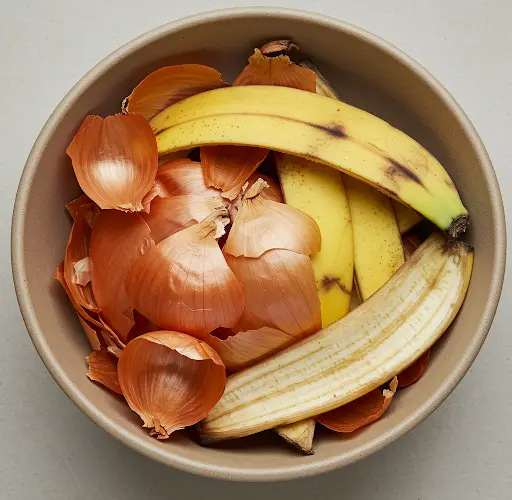If you’re looking for a natural, cost-effective way to boost plant health, enhance flowering, and increase fruit production, making your own liquid fertilizer from kitchen scraps like onion peels and banana peels is an excellent solution. This simple DIY recipe transforms common household waste into a nutrient-rich tonic that can dramatically improve your garden’s productivity.
Regular application of this homemade fertilizer leads to stronger roots, greener leaves, more abundant flowers, and improved resistance to pests and diseases. It’s a smart way to nurture your garden without relying on chemical products.
Why Onion and Banana Peels?
Both onion and banana peels are loaded with essential nutrients that plants need to thrive.
-
Onion peels are a rich source of sulfur, which plays a key role in the production of amino acids, enzymes, and vitamins within the plant. Sulfur is essential for robust growth and contributes to disease resistance. Onion peels also contain potassium and calcium, which support strong root systems and healthy plant structure.
-
Banana peels are high in potassium, phosphorus, and calcium. Potassium regulates water movement within plants, strengthens stems, and improves tolerance to drought and disease. Phosphorus promotes strong root growth, enhances flowering, and supports fruit development. Calcium is critical for healthy cell division and preventing issues like blossom end rot in fruiting crops.
When these peels are steeped in water, their nutrients are slowly released into the liquid, creating a potent organic fertilizer.
How to Make the Fertilizer
Ingredients:
-
Onion peels (enough to fill one small container)
-
Banana peels (enough to fill a second small container)
-
Lukewarm water
-
Two containers with lids
-
A 5-gallon bucket (or 10-liter container)
-
5 liters of compost tea (optional but highly recommended)
Instructions:
-
Separate the peels
Place onion peels in one container and banana peels in another. Make sure each container has a secure lid. -
Add lukewarm water
Fill both containers with lukewarm water until the peels are fully submerged. The warm water helps speed up the nutrient extraction process. -
Seal and steep
Close the lids tightly to keep insects out and allow the natural fermentation process to take place. Let the containers sit for 7 days. During this time, the water will absorb nutrients from the peels. -
Strain the liquids
After one week, strain the contents of both containers to remove the solid peels. Pour the nutrient-rich liquid into a 10-liter (5-gallon) bucket. -
Enhance with compost tea (optional)
Add 5 liters of compost tea to the bucket for an extra nutrient and microbial boost. Compost tea introduces beneficial bacteria and fungi that improve nutrient uptake and promote soil health. -
Mix thoroughly
Stir the mixture well to ensure all components are evenly distributed. The fertilizer is now ready for use.
How to Use the Fertilizer
Before applying, make sure the solution is well-diluted and mixed. Use the liquid to water your plants directly at the base, avoiding leaves to prevent any potential burning or mold growth.
Apply once every 1–2 weeks, depending on the needs of your plants. This schedule provides a steady supply of nutrients without overwhelming young or sensitive crops.
Benefits of This Organic Fertilizer
-
Stronger, healthier plants
Regular use leads to visibly healthier foliage, stronger stems, and more vibrant blooms. -
Enhanced root development
Phosphorus and calcium from the banana peels help establish deep, healthy root systems. -
Better flowering and fruiting
Potassium promotes abundant flowering and high-quality fruit production. -
Improved soil health
When combined with compost tea, this fertilizer supports microbial life in the soil, helping to break down organic matter and make nutrients more available to plants. -
Natural disease resistance
Sulfur and beneficial microbes help strengthen plant immunity and outcompete soil-borne pathogens. -
Eco-friendly and sustainable
This method recycles kitchen waste and reduces the need for chemical fertilizers, benefiting both your garden and the environment.
Final Thoughts
Making your own organic liquid fertilizer from onion and banana peels is not only easy but also highly effective. It’s a perfect example of how simple, natural ingredients can deliver powerful results in the garden. By feeding your plants with this nutrient-rich solution, you’re investing in long-term soil fertility and overall plant health.
Give it a try in your garden—you’ll likely see improved growth, resilience, and productivity in a matter of weeks. Plus, it’s a satisfying way to reduce waste and take a more sustainable approach to gardening.



